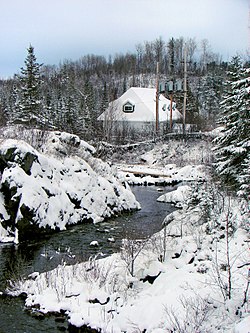발암
Carcinisation발암(또는 발암)은 갑각류가 비파괴적 형태에서 게와 같은 형태로 진화하는 융합적 진화의 한 예다. 이 용어는 L. A. Borradaile에 의해 진화 생물학에 도입되었는데, 그는 이것을 "자연이 게를 진화시키려는 많은 시도 중 하나"[2]라고 묘사했다. 발암된 갑각류는 대부분 인프라 주문인 아모누라에 속한다.
발암 형태학의 정의
랜슬롯 알렉산더 보라다일레([3]Alexander Borradaile)는 1916년에 다음과 같이 진술하였다.
... 발암 …은 근본적으로 거무스름한 갑각류의 복부를 수축시키는 것과 더불어 우울증 및 두족류 확대와 함께 구성되어 있어서, 그 동물은 게의 일반적인 체질을 전제로 한다.
Keiler 외, 2017은 발암 형태학을 다음과 같이 정의한다.[4]
- "카라피스는 넓을 때보다 평탄하고 측면 여백을 가지고 있다."
- "선미들은 넓은 흉골 플라스티론에 융합되어 있는데, 이 플라스티론은 뒤쪽 여백에 뚜렷한 유착을 가지고 있다.
- "플론은 평평하고 강하게 구부러져 있으며, 등측으로 볼 때 네 번째 늑골 부분의 테르그이트를 완전히 숨기고 있으며, 플라스톤을 부분적으로 또는 완전히 덮는다."
예
발암은 적어도 5개 그룹의 디카포드 갑각류에서 독립적으로 발생한 것으로 생각된다.[4]
- 디카포다 주문:
멸종될 가능성이 있는 갑각류 양식인 사이클리다는 또한 "스트라이킹할 정도로 게를 닮았다"고 알려져 있으며, 아마도 비슷한 생태계를 가지고 있었을 것이다.[11][12]
태음인은 형태학에서는 게처럼 보였을지 몰라도 행동에서는 그렇지 않을 것이다.[citation needed]
킹크랩
소라게에서 진화하는 킹크랩(가족 리토다과)의 예는 특히 잘 연구되어 왔으며, 이들의 생물학에서 증거가 이 이론을 뒷받침하고 있다. 예를 들어, 대부분의 소라게들은 비대칭적이어서 나선달팽이 껍질에 잘 맞는다; 킹크랩의 복부는 그들이 대피소로 달팽이껍질을 사용하지 않아도 또한 비대칭이다.[13][14][15][16]
하이퍼카르신화
"하이퍼카르신화"라고 불리는 예외적인 형태의 발암은 자기 게 알로페트로리스테스 스피니프론에서 볼 수 있다. A. 스피니프론은 짧아진 체형 외에도 수컷이 암컷에 비해 늑골이 짧은 참게에서 볼 수 있는 것과 유사한 성 이형성을 보인다.[17]
참고 항목
참조
- ^ Baeza, J. Antonio (2016-03-10). "Molecular phylogeny of porcelain crabs (Porcellanidae: Petrolisthes and allies) from the south eastern Pacific: the genera Allopetrolisthes and Liopetrolisthes are not natural entities". PeerJ. 4: e1805. doi:10.7717/peerj.1805. ISSN 2167-8359. PMC 4793318. PMID 26989636.
- ^ Patsy A. McLaughlin; Rafael Lemaitre (1997). "Carcinization in the Anomura – fact or fiction? I. Evidence from adult morphology". Contributions to Zoology. 67 (2): 79–123. doi:10.1163/18759866-06702001. 웨이백 머신에 PDF 보관 2012-04-02
- ^ 보라다일 LA 1916년 갑각류. 제2부. 포르셀라노파구루스: 발암 자연사 보고서, 동물학 3: 111–126.
- ^ a b Keiler, Jonas; Wirkner, Christian S.; Richter, Stefan (2017-05-01). "One hundred years of carcinization – the evolution of the crab-like habitus in Anomura (Arthropoda: Crustacea)". Biological Journal of the Linnean Society. 121 (1): 200–222. doi:10.1093/biolinnean/blw031. ISSN 0024-4066.
- ^ Jonas Keiler; Stefan Richter; Christian S. Wirkner (2013). "Evolutionary morphology of the hemolymph vascular system in hermit and king crabs (Crustacea: Decapoda: Anomala)". Journal of Morphology. 274 (7): 759–778. doi:10.1002/jmor.20133. PMID 23508935. S2CID 24458262.
- ^ Jonas Keiler; Stefan Richter; Christian S. Wirkner (2015). "The anatomy of the king crab Hapalogaster mertensii Brandt, 1850 (Anomura: Paguroidea: Hapalogastridae) – new insights into the evolutionary transformation of hermit crabs into king crabs". Contributions to Zoology. 84 (2): 149–165. doi:10.1163/18759866-08402004.
- ^ Jonas Keiler; Stefan Richter; Christian S. Wirkner (2014). "Evolutionary morphology of the organ systems in squat lobsters and porcelain crabs (Crustacea: Decapoda: Anomala): an insight into carcinization". Journal of Morphology. 276 (1): 1–21. doi:10.1002/jmor.20311. PMID 25156549. S2CID 26260996.
- ^ Jonas Keiler; Stefan Richter; Christian S. Wirkner (2016). "Revealing their innermost secrets: an evolutionary perspective on the disparity of the organ systems in anomuran crabs (Crustacea: Decapoda: Anomura)". Contributions to Zoology. 85 (4): 361–386. doi:10.1163/18759866-08504001.
- ^ "Remarkable new true crab-like hermit discovered". Florida Museum. University of Florida. 13 December 2013. Archived from the original on October 25, 2020. Retrieved December 9, 2020.
- ^ C. L. Morrison; A. W. Harvey; S. Lavery; K. Tieu; Y. Huang; C. W. Cunningham (2001). "Mitochondrial gene rearrangements confirm the parallel evolution of the crab-like form" (PDF). Proceedings of the Royal Society B: Biological Sciences. 269 (1489): 345–350. doi:10.1098/rspb.2001.1886. PMC 1690904. PMID 11886621. Archived (PDF) from the original on 2010-06-10. Retrieved 2010-03-26.
- ^ Günter Schweigert (2007). "Juracyclus posidoniae n. gen. and sp., the first cycloid arthropod from the Jurassic" (PDF). Journal of Paleontology. 81 (1): 213–215. CiteSeerX 10.1.1.490.9065. doi:10.1666/0022-3360(2007)81[213:JPNGAS]2.0.CO;2. Archived (PDF) from the original on 2018-07-21. Retrieved 2020-08-30.
- ^ Castro, Peter; Davie, Peter; Guinot, Danièle; Schram, Frederick, eds. (2015-01-01), "Introduction to Brachyura", Treatise on Zoology - Anatomy, Taxonomy, Biology. The Crustacea, Volume 9 Part C (2 vols), BRILL, pp. 3–9, doi:10.1163/9789004190832_003, ISBN 978-90-04-19083-2, retrieved 2021-11-04
- ^ C. W. Cunningham; N. W. Blackstone; L. W. Buss (1992). "Evolution of king crabs from hermit crab ancestors". Nature. 355 (6360): 539–542. Bibcode:1992Natur.355..539C. doi:10.1038/355539a0. PMID 1741031. S2CID 4257029.
- ^ Patsy A. McLaughlin; Rafael Lemaitre; Christopher C. Tudge (2004). "Carcinization in the Anomura – fact or fiction? II. Evidence from larval, megalopal and early juvenile morphology". Contributions to Zoology. 73 (3): 165–205. doi:10.1163/18759866-07303001.
- ^ Ling Ming Tsang; Tin-Yam Chan; Shane T. Ahyong; Ka Hou Chu (2011). "Hermit to king, or hermit to all: multiple transitions to crab-like forms from hermit crab ancestors". Systematic Biology. 60 (5): 616–629. doi:10.1093/sysbio/syr063. PMID 21835822.
- ^ Rafael Lemaitre; Patsy A. McLaughlin (2009). "Recent advances and conflicts in concepts of anomuran phylogeny (Crustacea: Malacostraca)" (PDF). Arthropod Systematics & Phylogeny. 67 (2): 119–135. Archived from the original (PDF) on 2016-08-03. Retrieved 2011-11-19.
- ^ Alexandra Hiller; Carlos Antonio Viviana; Bernd Werding (2010). "Hypercarcinisation: an evolutionary novelty in the commensal porcellanid Allopetrolisthes spinifrons (Crustacea: Decapoda: Porcellanidae)" (PDF). Nauplius. 18 (1): 95–102. Archived from the original (PDF) on 2012-04-25.




